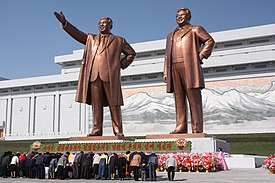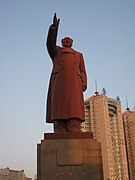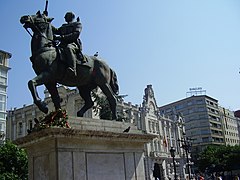Cult of personality

Soviet poster featuring Stalin, Soviet Azerbaijan, 1938
A cult of personality arises when a country's regime – or, more rarely, an individual – uses the techniques of mass media, propaganda, the big lie, spectacle, the arts, patriotism, and government-organized demonstrations and rallies to create an idealized, heroic, and worshipful image of a leader, often through unquestioning flattery and praise. A cult of personality is similar to apotheosis, except that it is established by modern social engineering techniques, usually by the state or the party in one-party states and dominant-party states. It is often seen in totalitarian or authoritarian countries.
The term came to prominence in 1956, in Nikita Khrushchev's secret speech On the Cult of Personality and Its Consequences, given on the final day of the 20th Congress of the Communist Party of the Soviet Union. In the speech, Khrushchev, who was the First Secretary of the Communist Party – in effect, the leader of the country – criticized the lionization and idealization of Joseph Stalin, and, by implication, his Communist contemporary Mao Zedong, as being contrary to Marxist doctrine. The speech was later made public and was part of the "de-Stalinization" process the Soviet Union went through.
Contents
1 Background
2 Characteristics
3 The role of the media
4 Purpose
5 In popular culture
6 Gallery
7 See also
8 References
9 External links
Background

Augustus of Prima Porta, 1st century AD
The Imperial cult of ancient Rome identified emperors and some members of their families with the divinely sanctioned authority (auctoritas) of the Roman State. Throughout history, monarchs and other heads of state were often held in enormous reverence and imputed super-human qualities. Through the principle of the divine right of kings, in medieval Europe for example, rulers were said to hold office by the will of God. Ancient Egypt, Imperial Japan, the Inca, the Aztecs, Tibet, Siam (now Thailand), and the Roman Empire are especially noted for redefining monarchs as "god-kings".
The spread of democratic and secular ideas in Europe and North America in the 18th and 19th centuries made it increasingly difficult for monarchs to preserve this aura. However, the subsequent development of mass media, such as radio, enabled political leaders to project a positive image of themselves onto the masses as never before. It was from these circumstances in the 20th century that the most notorious personality cults arose. Often these cults are a form of political religion.[1]
The term "cult of personality" probably appeared in English around 1800–1850, along with the French and German use.[2] At first it had no political connotations but was instead closely related to the Romantic "cult of genius".[2] The political use of the phrase came first in a letter from Karl Marx to German political worker, Wilhelm Blos, 10 November 1877:[2]

North Koreans bowing in front of the statues of Kim Il-sung (left) and Kim Jong-il at the Mansudae Grand Monument
.mw-parser-output .templatequoteoverflow:hidden;margin:1em 0;padding:0 40px.mw-parser-output .templatequote .templatequoteciteline-height:1.5em;text-align:left;padding-left:1.6em;margin-top:0
Neither of us cares a straw of popularity. Let me cite one proof of this: such was my aversion to the personality cult [orig. Personenkultus] that at the time of the International, when plagued by numerous moves [...] to accord me public honor, I never allowed one of these to enter the domain of publicity [...][2][3]
Characteristics
There are various views about what constitutes a cult of personality in a leader. Historian Jan Plamper has written that modern-day personality cults display five characteristics that set them apart from "their predecessors": The cults are secular and "anchored in popular sovereignty"; their objects are all males; they target the entire population, not only the well-to-do or just the ruling class; they use mass media; and they exist where the mass media can be controlled enough to inhibit the introduction of "rival cults".[4]
In his What is character and why it really does matter, Thomas A. Wright states, "The cult of personality phenomenon refers to the idealized, even god-like, public image of an individual consciously shaped and molded through constant propaganda and media exposure. As a result, one is able to manipulate others based entirely on the influence of public personality...the cult of personality perspective focuses on the often shallow, external images that many public figures cultivate to create an idealized and heroic image."[5]
Adrian Teodor Popan defines cult of personality as a "quantitatively exaggerated and qualitatively extravagant public demonstration of praise of the leader". He also identifies three causal "necessary, but not sufficient, structural conditions, and a path dependent chain of events which, together, lead to the cult formation: a particular combination of patrimonialism and clientelism, lack of dissidence, and systematic falsification pervading the society’s culture."[6][7]
The role of the media
The media has played an instrumental role in forging national leaders' cults of personality.
Thomas A. Wright reports that "It is becoming evident that the charismatic leader, especially in politics, has increasingly become the product of media and self-exposure."[5] And, focusing on the media in the United States, Robert N. Bellah adds that, "It is hard to determine the extent to which the media reflect the cult of personality in American politics and to what extent they have created it. Surely they did not create it all alone, but just as surely they have contributed to it. In any case, American politics is dominated by the personalities of political leaders to an extent rare in the modern world...in the personalised politics of recent years the "charisma" of the leader may be almost entirely a product of media exposure."[8]
Enjoying repeated electoral success; particularly his third election victory in 2008, Silvio Berlusconi, an Italian media tycoon and politician who served as Prime Minister of Italy in four governments, was the most controversial head of government in the EU.[9][10] He is the controlling shareholder of Mediaset and owned the Italian football club A.C. Milan from 1986 to 2017. Forbes magazine ranked him 12th in the List of The World's Most Powerful People due to his domination of Italian politics in 2009.[11]
Purpose
Often, a single leader became associated with this revolutionary transformation and came to be treated as a benevolent "guide" for the nation without whom the transformation to a better future could not occur. This has been generally the justification for personality cults that arose in totalitarian societies, such as those of Adolf Hitler, Joseph Stalin, and Mao Zedong. Jan Plamper argues while Napoleon III made some innovations it was Benito Mussolini in Italy in the 1920s who originated the model of dictator-as-cult-figure that was emulated by Hitler, Stalin and the others, using the propaganda powers of a totalitarian state.[12]
Pierre du Bois argues that the Stalin cult was elaborately constructed to legitimize his rule. Many deliberate distortions and falsehoods were used.[13] The Kremlin refused access to archival records that might reveal the truth, and key documents were destroyed. Photographs were altered and documents were invented.[14] People who knew Stalin were forced to provide "official" accounts to meet the ideological demands of the cult, especially as Stalin himself presented it in 1938 in Short Course on the History of the All-Union Communist Party (Bolsheviks) , which became the official history.[15]
Historian David L. Hoffmann states "The Stalin cult was a central element of Stalinism, and as such it was one of the most salient features of Soviet rule...Many scholars of Stalinism cite the cult as integral to Stalin's power or as evidence of Stalin's megalomania."[16]
In popular culture
The American band Living Colour won a Grammy Award for Best Hard Rock Performance in 1990 for their song "Cult of Personality".[17] The song includes references to Mahatma Gandhi, John F. Kennedy, Benito Mussolini, Franklin D. Roosevelt, Joseph Stalin, and Malcolm X.
Gallery

Statue of Mao Zedong in modern China

Equestrian statue of Francisco Franco in Santander, Spain

Golden statue of Saparmurat Niyazov atop the Monument of Neutrality in Ashgabat, Turkmenistan

Ho Chi Minh statue in front of the City Hall of Ho Chi Minh City, Vietnam

A portrait of Mustafa Kemal Atatürk in Istanbul, Turkey

Bust of Ferdinand Marcos in Tuba, Philippines
See also
|
|
|
References
Notes
^ Jan Plamper. The Stalin Cult: A Study in the Alchemy of Power. New Haven, Conn.: Yale University Press. 2012. pp.13–14.
^ abcd Heller, Klaus (2004). Personality Cults in Stalinism. Isd. pp. 23–33. ISBN 978-3-89971-191-2..mw-parser-output cite.citationfont-style:inherit.mw-parser-output .citation qquotes:"""""""'""'".mw-parser-output .citation .cs1-lock-free abackground:url("//upload.wikimedia.org/wikipedia/commons/thumb/6/65/Lock-green.svg/9px-Lock-green.svg.png")no-repeat;background-position:right .1em center.mw-parser-output .citation .cs1-lock-limited a,.mw-parser-output .citation .cs1-lock-registration abackground:url("//upload.wikimedia.org/wikipedia/commons/thumb/d/d6/Lock-gray-alt-2.svg/9px-Lock-gray-alt-2.svg.png")no-repeat;background-position:right .1em center.mw-parser-output .citation .cs1-lock-subscription abackground:url("//upload.wikimedia.org/wikipedia/commons/thumb/a/aa/Lock-red-alt-2.svg/9px-Lock-red-alt-2.svg.png")no-repeat;background-position:right .1em center.mw-parser-output .cs1-subscription,.mw-parser-output .cs1-registrationcolor:#555.mw-parser-output .cs1-subscription span,.mw-parser-output .cs1-registration spanborder-bottom:1px dotted;cursor:help.mw-parser-output .cs1-ws-icon abackground:url("//upload.wikimedia.org/wikipedia/commons/thumb/4/4c/Wikisource-logo.svg/12px-Wikisource-logo.svg.png")no-repeat;background-position:right .1em center.mw-parser-output code.cs1-codecolor:inherit;background:inherit;border:inherit;padding:inherit.mw-parser-output .cs1-hidden-errordisplay:none;font-size:100%.mw-parser-output .cs1-visible-errorfont-size:100%.mw-parser-output .cs1-maintdisplay:none;color:#33aa33;margin-left:0.3em.mw-parser-output .cs1-subscription,.mw-parser-output .cs1-registration,.mw-parser-output .cs1-formatfont-size:95%.mw-parser-output .cs1-kern-left,.mw-parser-output .cs1-kern-wl-leftpadding-left:0.2em.mw-parser-output .cs1-kern-right,.mw-parser-output .cs1-kern-wl-rightpadding-right:0.2em
^ Blos, Wilhelm. "Brief von Karl Marx an Wilhelm Blos". Denkwürdigkeiten eines Sozialdemokraten. Retrieved 22 February 2013.
^ The Stain Cult: A Study in the Alchemy of Power. p. 222
^ ab What is character and why it really does matter. p.29
^ See Adrian Teodor Popan, The ABC of Sycophancy. Structural Conditions for the Emergence of Dictators’ Cults of Personality (PhD dissertation U of Texas 2015). Bibliography pp 196–213.online
^ Popan, Adrian Teodor (August 2015). "The ABC of sycophancy : structural conditions for the emergence of dictators' cults of personality" (PDF). University of Texas at Austin. doi:10.15781/T2J960G15. hdl:2152/46763.
^ California Law Review. p.747
^ [Re-inventing the Italian Right: Territorial Politics, Populism and 'post-fascism' Carlo Ruzza, Stefano Fella, Political Science]
^ Ruzza, Carlo; Fella, Stefano (2009). Re-inventing the Italian Right: Territorial Politics, Populism and 'post-fascism'. Routledge. p. 227. ISBN 978-0-415-34461-6.
^ "#12 Silvio Berlusconi". Forbes. 11 November 2009. Archived from the original on 11 November 2012.
^ Jan Plamper, The Stalin Cult: A Study in the Alchemy of Power (Yale UP, 2012), pp 4, 12–14.
^ du Bois, Pierre (1984). "Stalin – Genesis of a Myth". Survey. A Journal of East & West Studies. 28 (1): 166–181. See abstract in David R. Egan; Melinda A. Egan (2007). Joseph Stalin: An Annotated Bibliography of English-Language Periodical Literature to 2005. Scarecrow Press. p. 157. ISBN 9780810866713.
^ Strong, Carol; Killingsworth, Matt (2011). "Stalin the Charismatic Leader?: Explaining the 'Cult of Personality' as a legitimation technique". Politics, Religion & Ideology. 12 (4): 391–411.
^ Maslov, N. N. (1989). "Short Course of the History of the All-Russian Communist Party (Bolshevik)—An Encyclopedia of Stalin's Personality Cult". Soviet Studies in History. 28 (3): 41–68.
^ Hoffmann, David L. (2013). "The Stalin Cult". The Historian. 75 (4): 909.
^ Here's List of Nominees from all 77 Categories. The Deseret News. Salt Lake City, Utah. 12 January 1990. page W7. Accessed 8 August 2017.
Further reading
- Apor, Balázs, Jan C. Behrends, Polly Jones, and E. A. Rees, eds.= The Leader Cult in Communist Dictatorships: Stalin and the Eastern Bloc (Palgrave Macmillan, 2004).
ISBN 1403934436.
The leader cult in communist dictatorships : Stalin and the Eastern Bloc. Palgrave Macmillan. 2004-10-11. ISBN 978-1403934437.- Heller, Klaus and Jan Plamper, eds. Personality Cults in Stalinism/Personenkulte im Stalinismus (Göttingen: V&R unipress, 2004).
ISBN 3899711912. . 472 pp
Personality cults in Stalinism / Personenkulte im Stalinismus (1. Aufl ed.). V & R Unipress. 2004. ISBN 978-3899711912.
Cohen, Yves (2007). "The cult of number one in an age of leaders" (PDF). Kritika: Explorations in Russian and Eurasian History. 8 (3): 597–634. Retrieved 7 September 2018.
Gill, Graeme (1984). "Personality cult, political culture and party structure". Studies in Comparative Communism. 17 (2): 111–121.
Melograni, Piero (1976). "The Cult of the Duce in Mussolini's Italy" (PDF). Journal of Contemporary History. 11 (4): 221–237. Retrieved 7 September 2018.- Morgan, Kevin. International Communism and the Cult of the Individual Leaders, Tribunes and Martyrs under Lenin and Stalin (2017)
Paltiel, Jeremy (1983). "The Cult of Personality: Some Comparative Reflections on Political Culture in Leninist Regimes". Studies in Comparative Communism'. 16: 49–64.- Petrone, Karen. “Cult of Personality”. in Encyclopedia of Russian History, vol 1. pp. 348–350 edited by J. R. Millar (2004).
Polese, Abel; Horák, Slavomir (2015). "A tale of two presidents: personality cult and symbolic nation-building in Turkmenistan". Nationalities Papers. 43 (3): 457–478.- Rutland, P. “Cult of Personality”. in The Encyclopedia of Political Science vol 1, p 365; edited by G. T. Kurian (CQ Press, 2011).
Tucker, Robert C. (1979). "The Rise of Stalin's Personality Cult" (PDF). American Historical Review. 84 (2): 347–366. Retrieved 7 September 2018.- Vassilev, Rossen. “Cult of Personality”. in International Encyclopedia of the Social Sciences (2008) edited by W. A. Darity Jr.
External links
Why Dictators Love Kitsch by Eric Gibson, The Wall Street Journal, August 10, 2009





